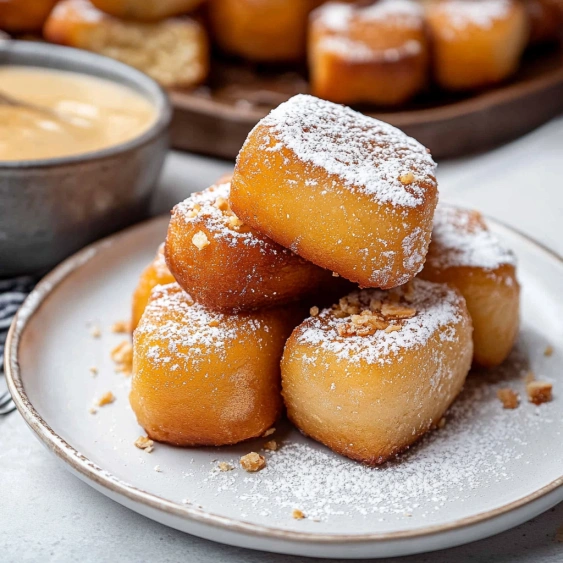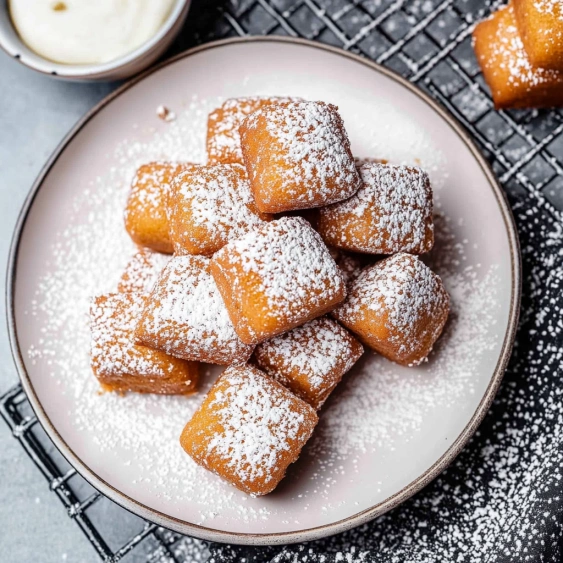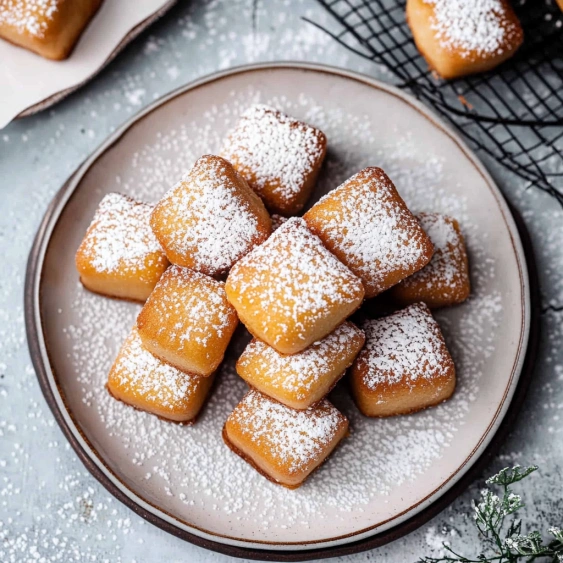 Pin it
Pin it
This classic French beignet recipe creates pillowy, sugar-dusted squares of fried dough that transport your taste buds straight to a New Orleans café. The overnight rising method develops complex flavors while the simple powdered sugar coating keeps them authentically delicious.
I first attempted these beignets after visiting New Orleans years ago and became determined to recreate that distinctive pillowy texture at home. After several attempts adjusting the dough consistency I finally achieved that perfect bite that reminds me of leisurely mornings at Café du Monde.
Ingredients
- Whole milk: lukewarm. The warmth activates the yeast while the fat content creates richer dough
- Granulated sugar: provides food for the yeast and balances the dough sweetness
- Fresh yeast: gives superior rise though instant yeast works well too
- Egg yolk: adds richness and tenderness to the final texture
- Whole egg: provides structure and helps create that distinctive beignet chew
- Bread flour: with higher protein creates better structure look for at least 12% protein content
- Salt: enhances all flavors and controls yeast activity for better texture
- Unsalted butter: room temperature incorporates better and creates tender layers
- Vegetable or canola oil: for frying choose a neutral oil with high smoke point
- Powdered sugar: for coating sift it for the most authentic fluffy coating
Step-by-Step Instructions
- Activate the Yeast:
- Combine lukewarm milk with sugar then sprinkle yeast on top. Allow to stand in a warm kitchen for 10 minutes until foamy. This activation period ensures your dough will rise properly and develops initial flavor compounds.
- Create the Base Dough:
- Place the activated yeast mixture into your stand mixer fitted with the kneading hook. Add the egg and egg yolk and mix until well combined. The eggs must be at room temperature to prevent shocking the yeast.
- Incorporate Dry Ingredients:
- Add flour and salt to the wet ingredients and knead until the dough begins to come together. This initial mixing creates the gluten structure that will give your beignets their distinctive chewy interior.
- Add Butter and Develop Gluten:
- Slowly incorporate soft butter pieces one at a time while kneading. Continue kneading for a full 10 minutes on medium high speed until the dough becomes smooth elastic shiny and no longer sticks to the sides of the bowl. This extended kneading develops the gluten network essential for perfect texture.
- First Rise:
- Transfer dough to a clean bowl and cover with plastic wrap or a tea towel. Allow to rise in the refrigerator overnight for best flavor or at room temperature for 1 to 2 hours until doubled in size. The slow cold fermentation develops complex flavors.
- Shape the Beignets:
- After rising gently punch down the dough to release air bubbles. On a lightly floured surface roll the dough to ¼ inch thickness. Use a pizza wheel to cut into 2.5inch squares. The precise thickness ensures proper cooking through the center.
- Second Rise:
- Place cut dough squares on individual pieces of baking paper and allow to rise at room temperature until visibly puffed about 1 to 2 hours. Find a warm draft free spot but avoid direct heat or sunlight which can create an uneven rise.
- Fry to Golden Perfection:
- Heat oil to precisely 180C/356F in a heavy bottomed pan. Fry 6 to 8 beignets at a time allowing enough space for expansion. Cook each side for approximately 1.5 minutes until deeply golden brown. The exact temperature ensures properly cooked interiors without burning.
- Drain and Coat:
- Transfer fried beignets to a wire rack lined with paper towels to absorb excess oil. While still hot generously coat with powdered sugar. The heat helps the sugar adhere creating that classic beignet finish.
 Pin it
Pin it
My grandmother taught me to let the dough rest overnight in the refrigerator which seemed tedious at first but I discovered it creates a noticeably more complex flavor profile. This patient approach transforms a simple dough into something truly special that always reminds me of Sunday mornings in her kitchen.
Troubleshooting Your Beignets
If your beignets aren't puffing properly during frying check your oil temperature. Too cool and they absorb excess oil becoming greasy. Too hot and they brown before cooking through the center. Invest in a good candy thermometer for consistent results every time. The perfect beignet should have a golden exterior with a hollow center separated by a thin layer of soft dough.
Make Ahead and Storage
While beignets are undeniably best fresh from the fryer you can prepare the dough up to 24 hours ahead. After the first rise punch down the dough wrap tightly in plastic and refrigerate. Let it come to room temperature for 30 minutes before rolling and cutting. For leftover beignets store in an airtight container at room temperature for 1 to 2 days and refresh briefly in a 300°F oven for 3 to 5 minutes before serving.
 Pin it
Pin it
The Cultural Significance of Beignets
These pillowy treats have deep roots in French culinary tradition but found their American home in New Orleans where they became iconic at Café du Monde. Traditionally served with chicory coffee they represent the fusion of French technique with American ingredients. In New Orleans they remain a beloved breakfast tradition especially during Mardi Gras celebrations when they become practically mandatory eating.
Frequently Asked Questions
- → Can I make the beignet dough in advance?
Yes! The dough actually benefits from an overnight rest in the refrigerator, which develops more flavor. You can prepare the dough up to 24 hours before frying.
- → What's the ideal oil temperature for frying beignets?
The ideal temperature is between 175-185°C (347-365°F). Using a kitchen thermometer is highly recommended as it ensures the beignets cook properly without absorbing excess oil.
- → Can I use active dry yeast instead of fresh yeast?
Yes, you can substitute the 12.5g fresh yeast with 5g (1.5 teaspoons) of instant yeast. If using active dry yeast, you'll need to activate it in the warm milk before proceeding.
- → Why are my beignets dense instead of fluffy?
Dense beignets typically result from insufficient proofing time or improper oil temperature. Ensure the dough has properly risen during both proofing stages and that your oil is at the correct temperature before frying.
- → How do I know when beignets are fully cooked?
Properly cooked beignets should be golden brown on all sides, taking about 1.5 minutes per side. They should puff up considerably and have a hollow sound when tapped lightly.
- → What's the best way to serve beignets?
Beignets are best served fresh and warm, immediately after dusting with powdered sugar. They pair wonderfully with coffee, especially café au lait, or hot chocolate for a traditional New Orleans experience.
